US Dollar Exchange Rates of
25th
Mar
2024
China Yuan 7.23
Report from China
Investment in Real Estate Development in 2023
The National Bureau of Statistics has reported that in 2023
investment in total real estate development dropped by
almost 10% from the previous year and there was a
decline of 9.3% in investment in residential buildings.
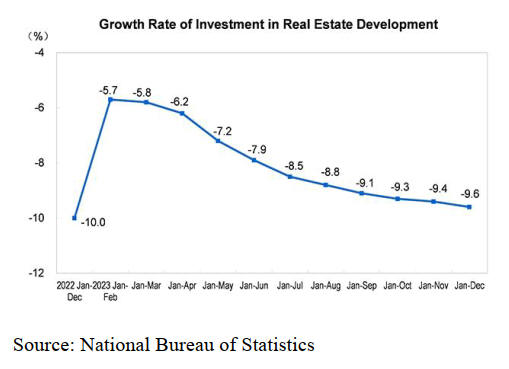
In 2023 the floor space under construction was 8,383
million square metres, down by 7% over the previous year
of which the floor space for residential buildings under
construction was down by 7.7%.
The floor space of buildings newly started was down by
20.4%, of which the floor space of residential buildings
newly started was down by over 20%. Investment in real
estate in the Eastern Region was down 5%, down 89% in
the Central Region, down 19% in the Western Region and
down 26% in the North Eastern region.
See:
https://www.stats.gov.cn/english/PressRelease/202402/t20240201_1947107.html
Number of plywood production enterprises fell in 2023
According to the Academy of Industry Development and
Planning under the National Forestry and Grassland
Administration (NFGA) and the China Forestry Products
Industry Association (CFPIA), the number of enterprises
in China’s plywood industry continued to decline in 2023.
There were more than 7,400 plywood manufacturing
enterprises in 2023, down 30% year on year, however, the
production capacity declined only slightly year on year
and stood at 205 million cubic metres in 2023.
For the first time Guangxi Zhuang Autonomous Region
exceeded Shandong in plywood production capacity in
2023 and thus became the largest in terms of plywood
production capacity. There were 1,430 mills in the
Guangxi Zhuang Autonomous Region with a capacity of
58 million cubic metres or around 30% of the national
total.
Shandong Province was the second largest in terms of
plywood production capacity and still had the largest
number of enterprises in 2023. There were 2,180 mills
with a capacity of 54 million cubic metres or 26% of the
national total.
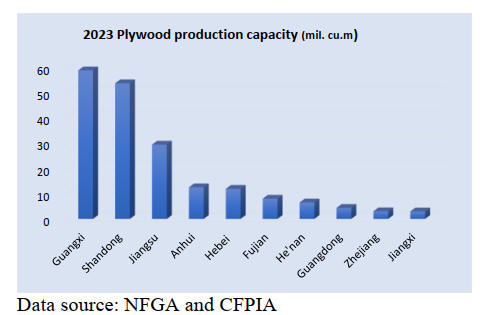
At the beginning of 2024 around 1,500 plywood
production plants were under construction nationwide with
a total annual production capacity of about 29 million
cubic metres. 24 provinces and autonomous regions had
plywood production enterprises under construction except
Beijing, Shanghai, Tianjin, Chongqing, Qinghai Province,
Ningxia Hui Autonomous Region and the Tibet
Autonomous Region.
Sector analysts say the plywood industry must
continuously adjust its product structure to adapt to
changes in market demand and improve the quality of
products and the image of the sector. It is expected that
annual plywood production capacity in China will drop to
200 million cubic metres by the end of 2024.
Under current market conditions the supply capacity of
China's plywood industry is greater than demand. The
production of plywood for furniture making, home
decoration and furnishing accounts for about 35% of the
market in China and supply and demand in these markets
is relatively well balanced.
In contrast, production capacity for concrete formwork
plywood accounts for about 24% of the overall market and
production capacity in this sector far exceeds current
demand. The packaging plywood market was impacted by
competition from Oriented Strand Board (OSB), so
packaging plywood production declined and its market
share was less than 22% of the national total.
Blockboard production accounts for about 12% of the
national panel product capacity and other products such as
plywood for wood composite floor basic materials,
container floors and veneer laminated wood etc. account
for about 7% of the national total.
Rise in plywood exports to UAE and Nigeria
China Customs data shows plywood exports to UAE and
Nigeria in 2023 rose 13% and 49% to 568,000 cubic
metres and 464,000 cubic metres valued at US$190
million and US$150 million respectively. In contrast,
China’s plywood exports to Japan in 2023 fell 20% to
545,000 cubic metres valued at US$265 million, down
33% year on year.
China exports plywood to more than 200 countries and
markets and the market share of the top 10 countries for
China’s plywood exports in 2023 accounted for just 50%
of the national total.
China’s plywood exports totalled 10.769 million cubic
metres valued at US$4.817 billion in 2023, up 1% in
volume but down 14% in value over 2022.
The Philippines and UK are China's two major markets for
plywood but plywood exports to these two markets
declined in 2023. Export volumes to the Philippines and
UK fell 4% and 3% respectively. This has affected the
export performance of China’s plywood sector.
The US is no longer the main destination for Chinese
exports. China's plywood exports to the United States
totalled only 284,000 cubic metres in 2023 worth US$210
million, down 33% in volume and 42% in value over
2022.

Plywood imports from Russia
According to data from China Customs, plywood imports
in 2023 totalled 295,000 cubic metres valued at US$206
million, up 51% in volume and 9% in value over 2022.
Russia was the largest supplier of plywood to China in
2023. China’s plywood imports from Russia rose 107% to
239,000 cubic metres accounting for 81% of the national
total import volume.
Chinese enterprises have built factories in Russia to
manufacture plywood and export to China via the China-
Europe railway and these enterprises account for most of
the increased exports.
Indonesia, Malaysia, Japan and Finland were also
suppliers of plywood imports in 2023. China’s plywood
imports from Finland rose but from Indonesia, Malaysia
and Japan fell in 2023. China’s plywood imports from the
top 5 suppliers made up 93% of the national total in 2023.

2023 particleboard production capacity
According to statistics from the Academy of Industry
Development and Planning under the National Forestry
and Grassland Administration (NFGA) and the China
Forestry Products Industry Association (CFPIA), both the
number of enterprises and total production capacity in
China’s particleboard industry rose in 2023.
There were more than 307 particleboard manufacturing
enterprises in 2023, up 4% year on year. The total annual
production capacity was 52.69 million cubic metres in
2023, up 27% over 2022.
Shandong Province was the largest in terms of
particleboard production capacity in 2023. There were 71
mills with a capacity of 9.2 million cubic metres,
accounting for 17% of the national total.

China's particleboard sector has seen a sharp rise
in
investment say local commentators and this inreases the
risk of imbalance between supply and demand. It is
forecast that mills now under construction will be
operational within 12-24 months and the annual
particleboard production capacity is expected to exceed 65
million cubic metres.
Surge in particleboard exports to Chile
China Customs data shows particleboard exports totalled
395,000 tonnes valued at US$275 million, up 7% in
volume but down 28% in value over 2022. Taiwan P.o.C,
Mongolia and Nigeria were the top 3 destinations in 2023.
Taiwan P.o.C was the largest destination for China’s
particleboard exports in 2023, up 24% to 83,000 tonnes
over 2022.
China’s particleboard exports to Chile surged 118% to
19,000 tonnes valued at US$8 million, up 118% over
2022. China exports of particleboard to Asia, Africa and
Latin America mainly for construction work associated
with the Belt and Road Initiative. The demand for low cost
particleboard in Asia, Africa and Latin America has
increased which has offered an opportunity for Chinese
exporters.
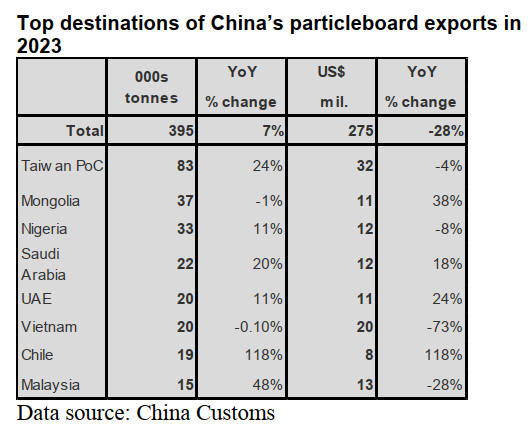
Surge in particleboard imports from Poland
Particleboard imports reached 757,000 tonnes valued at
US$336 million in 2023, down 2% in volume and 18% in
value over 2022. Thanks to the China-Europe freight train,
China has become Poland's second largest trading partner
and second largest source of imports. China’s
particleboard imports from Poland surged in 2023.

In 2023 particleboard imports from Thailand exceeded
those from Romania and became the largest supplier in
2023. The volume of China’s particleboard imports from
Thailand rose 89% to 273,000 tonnes valued at US$66
million, up 55% over 2022.
China’s particleboard imports from Belarus also surged in
2023. In contract, particleboard imports from Romania,
Brazil, Russia, Germany and Malaysia fell in 2023 which
drove down overall imports.
China GTI indices for February
In February, the GTI-China index registered 31.7%, a
decrease of 2.4 percentage points from the previous month
and was below the critical value (50%) for 3 consecutive
months indicating that the business prosperity of the
timber enterprises represented by the GTI-China index
declined from last month. In February, in celebration of
the Spring Festival, most of the timber enterprises halted
production resulting in a significant decrease of trading
activities.
As for the 11 sub-indices, the purchase price index was
above the critical value of 50%, while the remaining 10
sub-indexes were all below the critical value. Compared to
the previous month, the sub-indices for export orders,
existing orders, purchase prices, inventory of main raw
materials, and employees increased.
The sub-indices for production, new orders, inventory of
finished products, purchase quantity, import and delivery
time declined by 1.2 - 8.9 percentage points.
Main challenges reported by GTI-China enterprises
There was a slight increase in shipping costs
Orders were insufficient and it was difficult to
receive the final payments.
The production volume decreased compared with
previous years and the costs of running
equipment increased as a result of intermittent
operations.
China's timber market was sluggish due to a
downturn in real estate transactions.
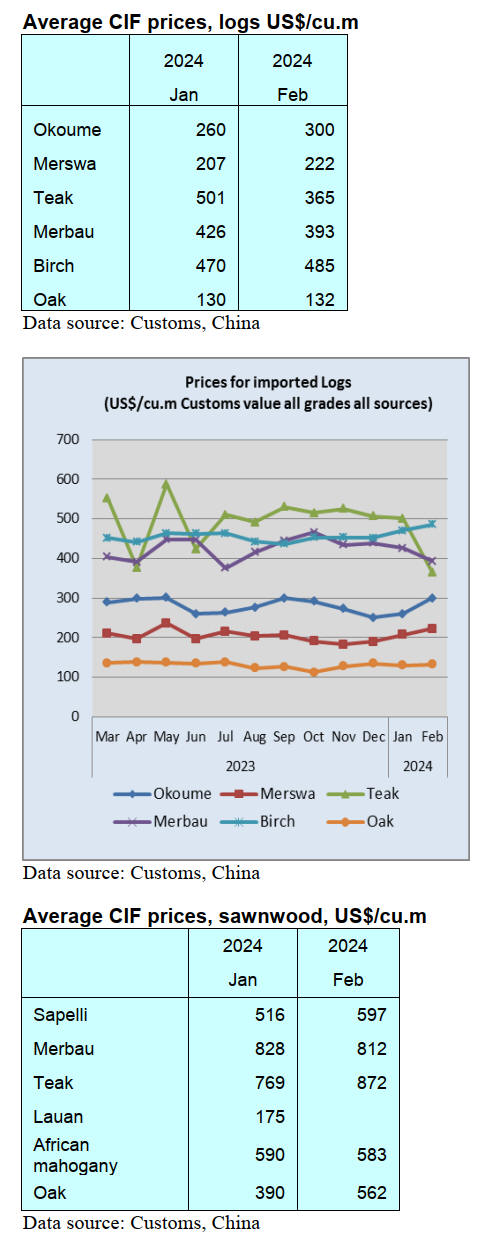
In tonnage terms this was the lowest on record, 8% less
than the previous low of 430,000 tonnes in 2015 (Chart 1).
This is around half the level of tropical wood imports into
the UK typical two decades ago before the 2007-2008
recession.
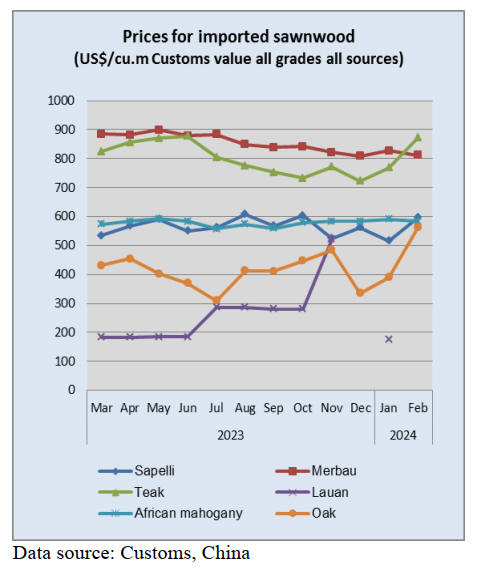
Through the eyes of industry
The latest GTI report lists the challenges identified by the private
sector in China.
https://www.itto-ggsc.org/static/upload/file/20240319/1710813683173232.pdf
|